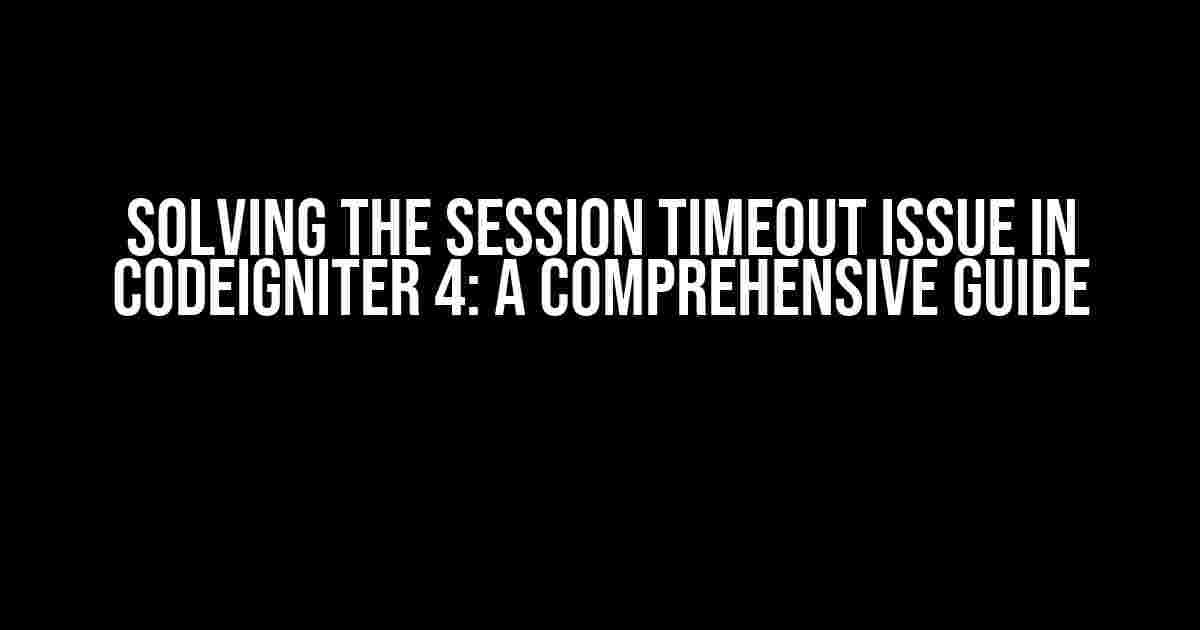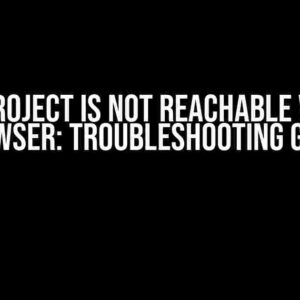Are you tired of dealing with session timeout issues in your CodeIgniter 4 application? Do you find yourself frustrated with users complaining about being logged out unexpectedly? Fear not, dear developer, for we’ve got you covered! In this article, we’ll dive deep into the world of session management in CodeIgniter 4 and provide you with a step-by-step guide on how to resolve the pesky session timeout issue once and for all.
What is Session Timeout?
Before we dive into the solution, let’s first understand what session timeout is. In simple terms, session timeout refers to the duration for which a user’s session remains active after they’ve logged in. When the timeout period expires, the user is automatically logged out, and their session is terminated. This is a security feature designed to protect users from unauthorized access.
Why does Session Timeout occur in CodeIgniter 4?
Session timeout issues in CodeIgniter 4 can occur due to various reasons, including:
- Incorrect configuration settings
- Insufficient server resources
- High traffic on the application
- Poor coding practices
Configuring Session Settings in CodeIgniter 4
To resolve the session timeout issue, we need to configure the session settings in CodeIgniter 4. By default, CodeIgniter 4 uses the `CI_Session` driver, which stores session data in the browser’s cookie. To modify the session settings, we need to update the `Config\App.php` file.
<?php
namespace Config;
class App
{
// ...
public $sessionTimeout = 300; // 5 minutes
public $sessionSavePath = WRITEPATH . 'session/';
}
In the above code, we’ve set the session timeout to 5 minutes (300 seconds). You can adjust this value according to your application’s requirements.
Using Database Sessions
Instead of using the default cookie-based session driver, we can use the database session driver to store session data. This approach provides more flexibility and security. To enable database sessions, update the `Config\App.php` file as follows:
<?php
namespace Config;
class App
{
// ...
public $sessionDriver = 'database';
public $sessionSavePath = 'ci_sessions';
}
Next, create a new table in your database to store session data:
CREATE TABLE IF NOT EXISTS ci_sessions ( id VARCHAR(128) NOT NULL, ip_address VARCHAR(45) NOT NULL, timestamp INT(10) UNSIGNED DEFAULT 0 NOT NULL, data BLOB DEFAULT NULL, PRIMARY KEY (id), KEY timestamp (timestamp) ) ENGINE=InnoDB DEFAULT CHARSET=utf8;
Implementing Session Refresh
To prevent sessions from timing out, we can implement a session refresh mechanism. This involves updating the session timestamp every time the user interacts with the application.
<?php
namespace App\Controllers;
class BaseController extends Controller
{
public function __construct()
{
// ...
$this->session->refresh();
}
}
In the above code, we’ve added a `refresh()` method to the `BaseController` constructor. This method updates the session timestamp every time a user interacts with the application.
Using AJAX Requests
Alternatively, we can use AJAX requests to refresh the session. This approach is useful when the user is actively using the application, but not necessarily interacting with the UI.
<script>
setInterval(function() {
$.ajax({
type: 'GET',
url: '',
success: function(data) {
console.log('Session refreshed!');
}
});
}, 300000); // 5 minutes
</script>
In the above code, we’ve used the jQuery `setInterval()` method to send an AJAX request to the `session/refresh` URL every 5 minutes. This request updates the session timestamp, refreshing the session.
Common Pitfalls to Avoid
When dealing with session timeout issues, it’s essential to avoid common pitfalls that can exacerbate the problem:
- Avoid using the `session_destroy()` method unnecessarily, as it can cause unexpected logouts.
- Don’t rely solely on client-side mechanisms to refresh the session, as they can be bypassed by malicious users.
- Ensure that your application is properly secured, using HTTPS and validating user input to prevent session fixation attacks.
Conclusion
Session timeout issues in CodeIgniter 4 can be frustrating, but with the right approach, you can resolve them efficiently. By configuring session settings, implementing session refresh mechanisms, and avoiding common pitfalls, you can provide a seamless user experience for your application’s users. Remember to stay vigilant and continuously monitor your application’s performance to ensure that session timeouts remain a thing of the past.
| Configuration Option | Description |
|---|---|
| $sessionTimeout | Sets the session timeout in seconds |
| $sessionSavePath | Specifies the directory where session files are stored |
| $sessionDriver | Sets the session driver (e.g., cookie, database) |
By following the guidelines outlined in this article, you’ll be well on your way to resolving the session timeout issue in CodeIgniter 4 and providing a secure, seamless user experience for your application’s users.
Bonus Tip: For added security, consider implementing a 2-factor authentication system to provide an extra layer of protection for your users.
We hope you found this article informative and helpful in resolving the session timeout issue in CodeIgniter 4. If you have any questions or need further clarification, please don’t hesitate to ask in the comments below!
- Have you encountered session timeout issues in your CodeIgniter 4 application?
- How do you currently handle session management in your application?
- Do you have any questions or need further clarification on the topic?
Share your thoughts and experiences in the comments below, and let’s continue the discussion!
Frequently Asked Questions
Q: What’s the default session timeout in CodeIgniter 4?
A: The default session timeout in CodeIgniter 4 is 7200 seconds (2 hours).
Q: Can I use both cookie and database sessions?
A: Yes, you can use both cookie and database sessions simultaneously. However, it’s recommended to use one or the other for consistency and security reasons.
Q: How do I clear the session data?
A: You can clear the session data using the `session_destroy()` method or by deleting the session files from the file system.
We hope this comprehensive guide has helped you resolve the session timeout issue in CodeIgniter 4. Remember to stay tuned for more informative articles and tutorials on CodeIgniter 4 development!
Frequently Asked Question
Get the answers to the most common questions about session timeout issues in CodeIgniter 4.
What causes session timeout issues in CodeIgniter 4?
Session timeout issues in CodeIgniter 4 can occur due to misconfiguration of the session settings, improper usage of session flashdata, or incorrect implementation of session timeouts in the application. It can also be caused by server-side issues, such as low session.gc_maxlifetime or session.gc_probability settings in the PHP configuration.
How to increase the session timeout in CodeIgniter 4?
To increase the session timeout in CodeIgniter 4, you can configure the session settings in the `app/Config/App.php` file. Set the `sessionTTL` value to the desired timeout period in seconds. For example, to set the timeout to 1 hour, set `public $sessionTTL = 3600;`. Additionally, you can also set `session.gc_maxlifetime` and `session.gc_probability` in the PHP configuration to avoid premature session expiration.
How to implement session timeouts for specific controllers or methods in CodeIgniter 4?
To implement session timeouts for specific controllers or methods in CodeIgniter 4, you can use the `beforeFilter` method in the controller or create a custom filter to check for session timeouts. You can also use the `session()->hasTimeout()` method to check if the session has timed out and redirect the user to the login page or take other desired actions.
What are the common symptoms of session timeout issues in CodeIgniter 4?
Common symptoms of session timeout issues in CodeIgniter 4 include unexpected logout, loss of session data, or errors related to session expiration. Users may also experience issues with flashdata or redirects after a certain period of inactivity.
How to debug session timeout issues in CodeIgniter 4?
To debug session timeout issues in CodeIgniter 4, enable the debug mode and check the session logs to identify the cause of the timeout. You can also use tools like PHP profiler or debuggers like Xdebug to analyze the application’s behavior and identify the issue. Additionally, review the server logs and PHP configuration to ensure that the session settings are correct.





